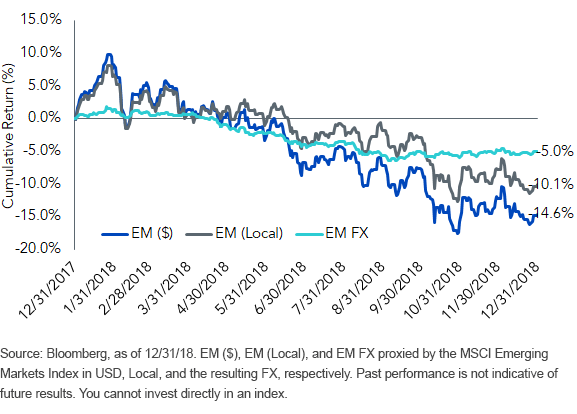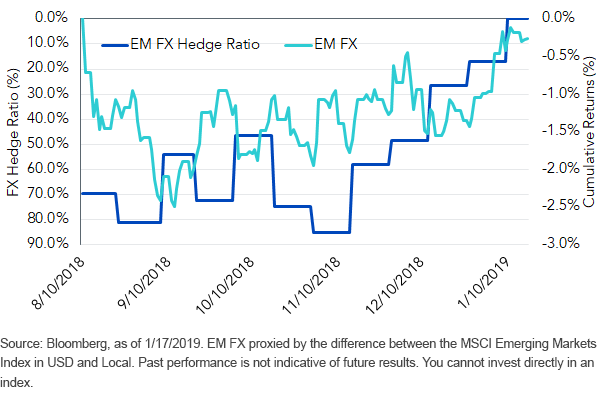Solving the Challenge of EM FX


In 2018, emerging market (EM) equities ended the year down nearly 15%. Approximately one-third of that loss was attributable to broad-based dollar strength against most EM currencies. Heading into 2019, we question whether investors should remain agnostic to managing EM foreign exchange (FX) risk.
Thinking in Bets
Anytime investors consider allocating internationally, they’re making two decisions: views on asset returns and views on currency returns. The more understood (and fretted-over) decision is whether or not the foreign asset will go up or down. However, the second decision has unfortunately been on autopilot for many U.S. investors. Due to benchmark decisions, a majority of investors default to the view that anytime they invest internationally, the value of the U.S. dollar will need to go down for them to capture local asset returns.
2018 EM Performance
After an amazing 2017, emerging markets faced headwinds over trade disputes, tighter central bank policies and concerns about the state of the global economy. In general, these risky assets underperformed. For investors that benchmark to the MSCI Emerging Markets Index, EM equities declined over 10%. Declines were 5% in the U.S., 7% in Europe and 15% in Japan. While no one was satisfied with last year’s peformance, we believe we’ve identified a solution for managing currency risk in EM portfolios.
EM Equity Returns, 12/31/17–12/31/18

Currency as a Factor
While most active managers have sought to focus on the value they can add via local asset returns, our research has found that adding value via currency decisions is just as important. In the WisdomTree Emerging Markets Multifactor Fund (EMMF), our active approach to factor investing is applied to both stock selection and currency selection. While equity selection focuses on value, quality, momentum and low correlation, the decision on currency hedging is determined by momentum. For example, if a specific EM currency is trending toward depreciation, an investor should hedge. While the trend in FX eventually will have an impact on the companies in that market, the investor feels these impacts much more immediately.
EMMF Currency Positioning
Markets are, by definition, dynamic. This is also the reason why we seek to adjust our FX hedges multiple times per month based on our model. In the chart below, we show EMMF’s FX positioning over time. As downside EM FX momentum began to stall, our dynamic approach to FX risk gradually reduced our hedges. In the second week of January, EMMF was currently 100% long EM FX.
EMMF Currency Hedging, 8/10/18–1/17/19

While active management has generally focused on security selection, we believe investors should continue to probe the decisions managers are making regarding FX risk. Through our dynamic approach, we believe we’ve identified a way to add value that helps solve the challenge that currency risk plays in emerging market portfolios.
Unless otherwise stated, all data is from Bloomberg as of December 31, 2018.
Important Risks Related to this Article
There are risks associated with investing, including possible loss of principal. Foreign investing involves special risks, such as risk of loss from currency fluctuation or political or economic uncertainty. Investments in securities and instruments traded in developing or emerging markets, or that provide exposure to such securities or markets, can involve additional risks relating to political, economic or regulatory conditions not associated with investments in U.S. securities and instruments or investments in more developed international markets. Funds focusing their investments on certain sectors and/or regions increase their vulnerability to any single economic or regulatory development. This may result in greater share price volatility. Investments in currency involve additional special risks, such as credit risk and interest rate fluctuations. The Fund invests in the securities included in, or representative of, its Index regardless of their investment merit and the Fund does not attempt to outperform its Index or take defensive positions in declining markets. Investments in non-U.S. securities involve political, regulatory and economic risks that may not be present in U.S. securities. For example, foreign securities may be subject to risk of loss due to foreign currency fluctuations, political or economic instability, or geographic events that adversely impact issuers of foreign securities. Derivatives used by the Fund to offset exposure to foreign currencies may not perform as intended. There can be no assurance that the Fund’s hedging transactions will be effective. The value of an investment in the Fund could be significantly and negatively impacted if foreign currencies appreciate at the same time that the value of the Fund’s equity holdings falls. While the Fund is actively managed, the Fund’s investment process is expected to be heavily dependent on quantitative models, and the models may not perform as intended. Please read each Fund’s prospectus for specific details regarding each Fund’s risk profile.


